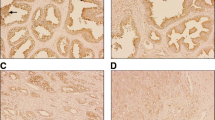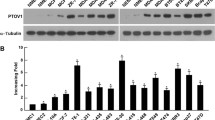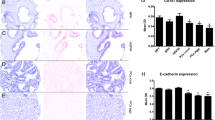Abstract
Gene products of the A disintegrin and metalloprotease (ADAM) family are critically involved in carcinogenesis and tumor progression of various solid tumors. Little is known about ADAM8 in prostate cancer. In our quest for novel diagnostic tissue markers of prostate cancer, we aimed to evaluate the expression of ADAM8 in prostate cancer and to correlate it with clinicopathological parameters. One hundred twenty-eight clinicopathologically characterized prostate cancer patients, with available follow-up data, were immunostained for ADAM8. Additionally, ADAM8 mRNA expression was quantified by real-time reverse transcription polymerase chain reaction (n = 59). ADAM8 protein expression was significantly associated with higher pT status, positive nodal status, and higher Gleason scores. Still, a significant prognostic value for the prostate-specific antigen relapse-free survival of ADAM8 could not be demonstrated. The differentiality of ADAM8 expression on protein and on mRNA level was low and partially inconclusive. Therefore, despite of its significant association with conventional parameters of an unfavorable prognosis, ADAM8 adds only limited information to the conventional histopathological assessment of prostate cancer.



Similar content being viewed by others
References
Amour A, Knight CG, English WR, Webster A, Slocombe PM, Knauper V, Docherty AJ, Becherer JD, Blobel CP, Murphy G (2002) The enzymatic activity of ADAM8 and ADAM9 is not regulated by TIMPs. FEBS Lett 524:154–158
Bjarnason JB, Fox JW (1995) Snake venom metalloendopeptidases: reprolysins. Methods Enzymol 248:345–368
Blanchot-Jossic F, Jarry A, Masson D, Bach-Ngohou K, Paineau J, Denis MG, Laboisse CL, Mosnier JF (2005) Up-regulated expression of ADAM17 in human colon carcinoma: co-expression with EGFR in neoplastic and endothelial cells. J Pathol 207:156–163
Carl-McGrath S, Lendeckel U, Ebert M, Roessner A, Rocken C (2005) The disintegrin-metalloproteinases ADAM9, ADAM12, and ADAM15 are upregulated in gastric cancer. Int J Oncol 26:17–24
Fourie AM, Coles F, Moreno V, Karlsson L (2003) Catalytic activity of ADAM8, ADAM15, and MDC-L (ADAM28) on synthetic peptide substrates and in ectodomain cleavage of CD23. J Biol Chem 278:30469–30477
Hammond ME, Fitzgibbons PL, Compton CC, Grignon DJ, Page DL, Fielding LP, Bostwick D, Pajak TF (2000) College of American Pathologists Conference XXXV: solid tumor prognostic factors—which, how and so what? Summary document and recommendations for implementation. Cancer Committee and Conference Participants. Arch Pathol Lab Med 124:958–965
Held-Feindt J, Paredes EB, Blomer U, Seidenbecher C, Stark AM, Mehdorn HM, Mentlein R (2006) Matrix-degrading proteases ADAMTS4 and ADAMTS5 (disintegrins and metalloproteinases with thrombospondin motifs 4 and 5) are expressed in human glioblastomas. Int J Cancer 118:55–61
Higuchi Y, Yasui A, Matsuura K, Yamamoto S (2002) CD156 transgenic mice. Different responses between inflammatory types. Pathobiology 70:47–54
Ishikawa N, Daigo Y, Yasui W, Inai K, Nishimura H, Tsuchiya E, Kohno N, Nakamura Y (2004) ADAM8 as a novel serological and histochemical marker for lung cancer. Clin Cancer Res 10:8363–8370
Jemal A, Siegel R, Ward E, Murray T, Xu J, Smigal C, Thun MJ (2006) Cancer statistics, 2006. CA Cancer J Clin 56:106–130
Karan D, Lin FC, Bryan M, Ringel J, Moniaux N, Lin MF, Batra SK (2003) Expression of ADAMs (a disintegrin and metalloproteases) and TIMP-3 (tissue inhibitor of metalloproteinase-3) in human prostatic adenocarcinomas. Int J Oncol 23:1365–1371
King NE, Zimmermann N, Pope SM, Fulkerson PC, Nikolaidis NM, Mishra A, Witte DP, Rothenberg ME (2004) Expression and regulation of a disintegrin and metalloproteinase (ADAM) 8 in experimental asthma. Am J Respir Cell Mol Biol 31:257–265
Kristiansen G, Sammar M, Altevogt P (2004) Tumour biological aspects of CD24, a mucin-like adhesion molecule. J Mol Histol 35:255–262
Kristiansen G, Pilarsky C, Wissmann C, Kaiser S, Bruemmendorf T, Roepcke S, Dahl E, Hinzmann B, Specht T, Pervan J, Stephan C, Loening S, Dietel M, Rosenthal A (2005) Expression profiling of microdissected matched prostate cancer samples reveals CD166/MEMD and CD24 as new prognostic markers for patient survival. J Pathol 205:359–376
Lendeckel U, Kohl J, Arndt M, Carl-McGrath S, Donat H, Rocken C (2005) Increased expression of ADAM family members in human breast cancer and breast cancer cell lines. J Cancer Res Clin Oncol 131:41–48
McCulloch DR, Akl P, Samaratunga H, Herington AC, Odorico DM (2004) Expression of the disintegrin metalloprotease, ADAM-10, in prostate cancer and its regulation by dihydrotestosterone, insulin-like growth factor I, and epidermal growth factor in the prostate cancer cell model LNCaP. Clin Cancer Res 10:314–323
McCulloch DR, Harvey M, Herington AC (2000) The expression of the ADAMs proteases in prostate cancer cell lines and their regulation by dihydrotestosterone. Mol Cell Endocrinol 167:11–21
Nath D, Slocombe PM, Webster A, Stephens PE, Docherty AJ, Murphy G (2000) Meltrin gamma(ADAM-9) mediates cellular adhesion through alpha(6)beta(1)integrin, leading to a marked induction of fibroblast cell motility. Mol Cell Endocrinol 113(Pt 12):2319–2328
Naus S, Richter M, Wildeboer D, Moss M, Schachner M, Bartsch JW (2004) Ectodomain shedding of the neural recognition molecule CHL1 by the metalloprotease-disintegrin ADAM8 promotes neurite outgrowth and suppresses neuronal cell death. J Biol Chem 279:16083–16090
Ohl F, Jung M, Xu C, Stephan C, Rabien A, Burkhardt M, Nitsche A, Kristiansen G, Loening SA, Radonic A, Jung K (2005) Gene expression studies in prostate cancer tissue: which reference gene should be selected for normalization? J Mol Med 83:1014–1024
Roemer A, Schwettmann L, Jung M, Stephan C, Roigas J, Kristiansen G, Loening SA, Lichtinghagen R, Jung K (2004) The membrane proteases adams and hepsin are differentially expressed in renal cell carcinoma. Are they potential tumor markers? J Urol 172:2162–2166
Schlomann U, Rathke-Hartlieb S, Yamamoto S, Jockusch H, Bartsch JW (2000) Tumor necrosis factor alpha induces a metalloprotease-disintegrin, ADAM8 (CD 156): implications for neuron–glia interactions during neurodegeneration. J Neurosci 20:7964–7971
Schlomann U, Wildeboer D, Webster A, Antropova O, Zeuschner D, Knight CG, Docherty AJ, Lambert M, Skelton L, Jockusch H, Bartsch JW (2002) The metalloprotease disintegrin ADAM8. Processing by autocatalysis is required for proteolytic activity and cell adhesion. J Biol Chem 277:48210–48219
Sivridis E, Touloupidis S, Giatromanolaki A (2002) Immunopathological prognostic and predictive factors in prostate cancer. Int Urol Nephrol 34:63–71
Wildeboer D, Naus S, Amy Sang QX, Bartsch JW, Pagenstecher A (2006) Metalloproteinase disintegrins ADAM8 and ADAM19 are highly regulated in human primary brain tumors and their expression levels and activities are associated with invasiveness. J Neuropathol Exp Neurol 65:516–527
Wolfsberg TG, Primakoff P, Myles DG, White JM (1995) ADAM, a novel family of membrane proteins containing A disintegrin and metalloprotease domain: multipotential functions in cell–cell and cell–matrix interactions. J Cell Biol 131:275–278
Yamamoto S, Higuchi Y, Yoshiyama K, Shimizu E, Kataoka M, Hijiya N, Matsuura K (1999) ADAM family proteins in the immune system. Immunol Today 20:278–284
Yoshida S, Setoguchi M, Higuchi Y, Akizuki S, Yamamoto S (1990) Molecular cloning of cDNA encoding MS2 antigen, a novel cell surface antigen strongly expressed in murine monocytic lineage. Int Immunol 2:585–591
Yoshiyama K, Higuchi Y, Kataoka M, Matsuura K, Yamamoto S (1997) CD156 (human ADAM8): expression, primary amino acid sequence, and gene location. Genomics 41:56–62
Acknowledgements
We are grateful to Britta Beyer for excellent technical assistance. The continuous support of Ilka Olson and Dr. Marius Fritzsche is greatly acknowledged.
Author information
Authors and Affiliations
Corresponding author
Rights and permissions
About this article
Cite this article
Fritzsche, F.R., Jung, M., Xu, C. et al. ADAM8 expression in prostate cancer is associated with parameters of unfavorable prognosis. Virchows Arch 449, 628–636 (2006). https://doi.org/10.1007/s00428-006-0315-1
Received:
Accepted:
Published:
Issue Date:
DOI: https://doi.org/10.1007/s00428-006-0315-1




